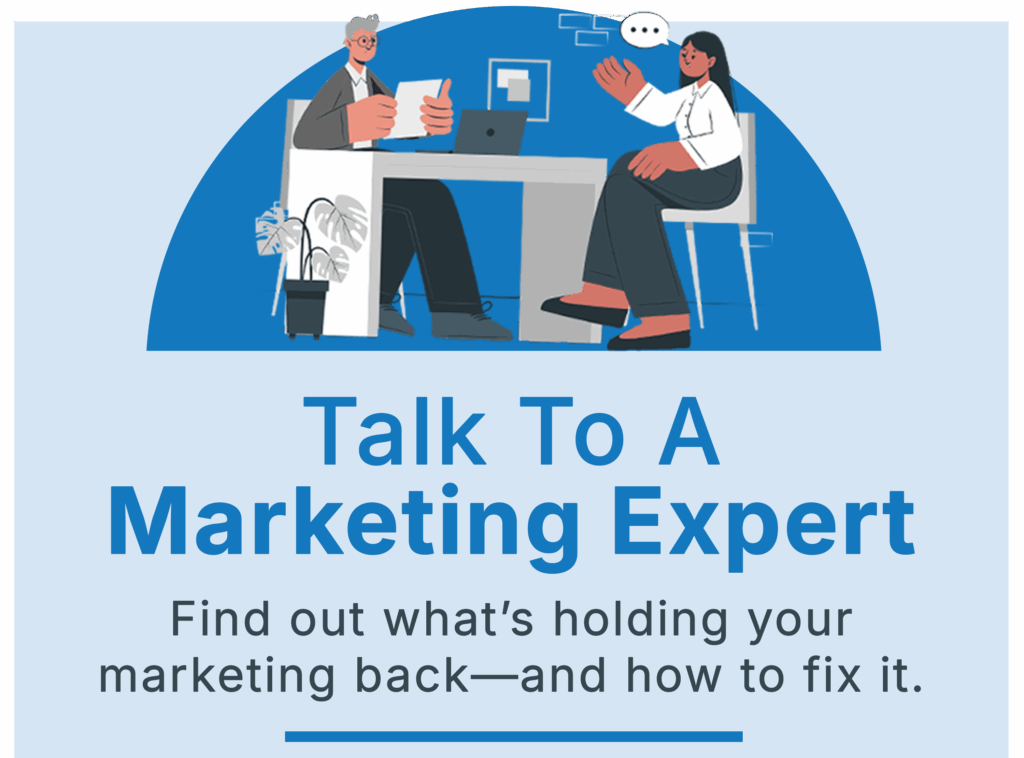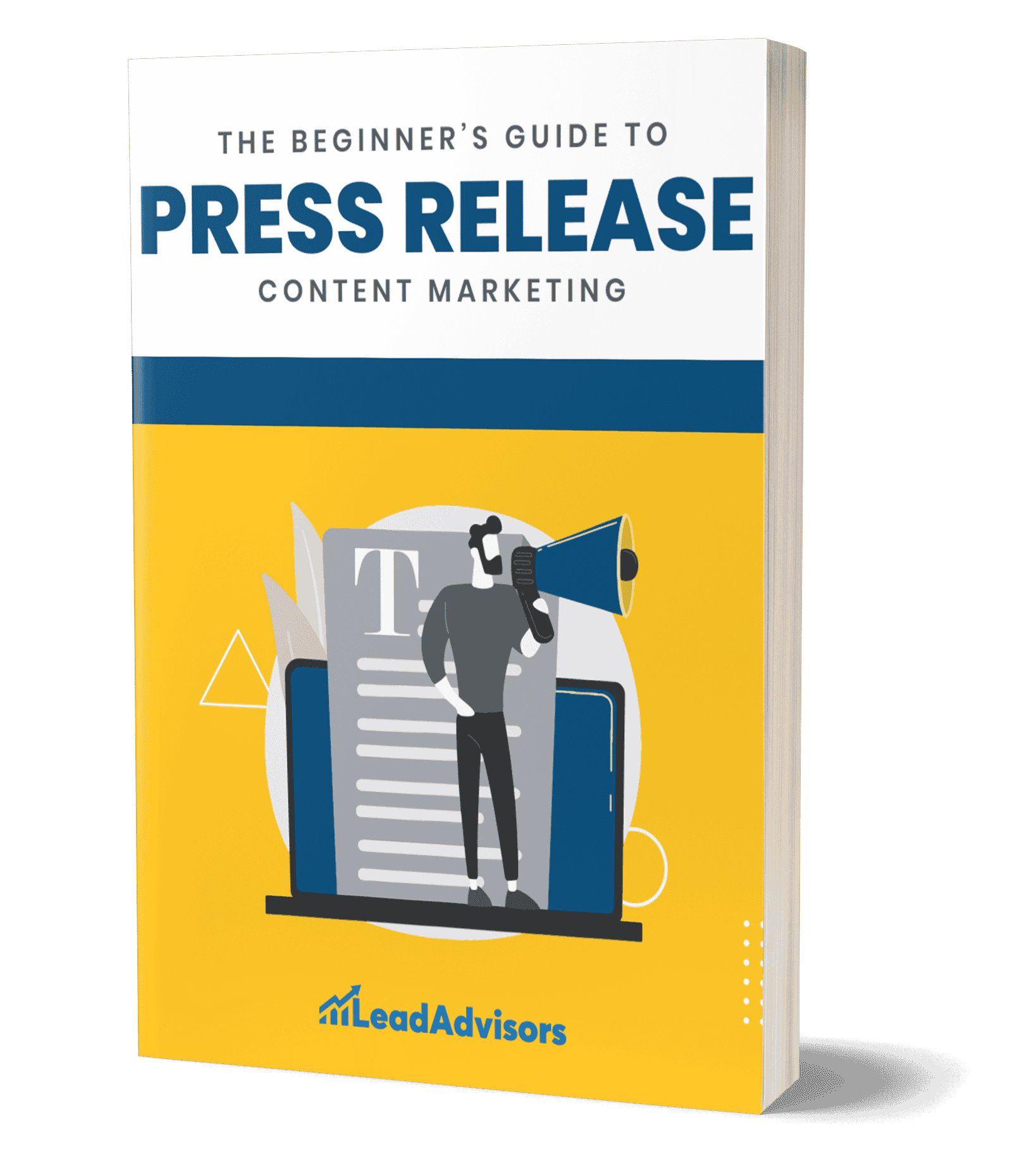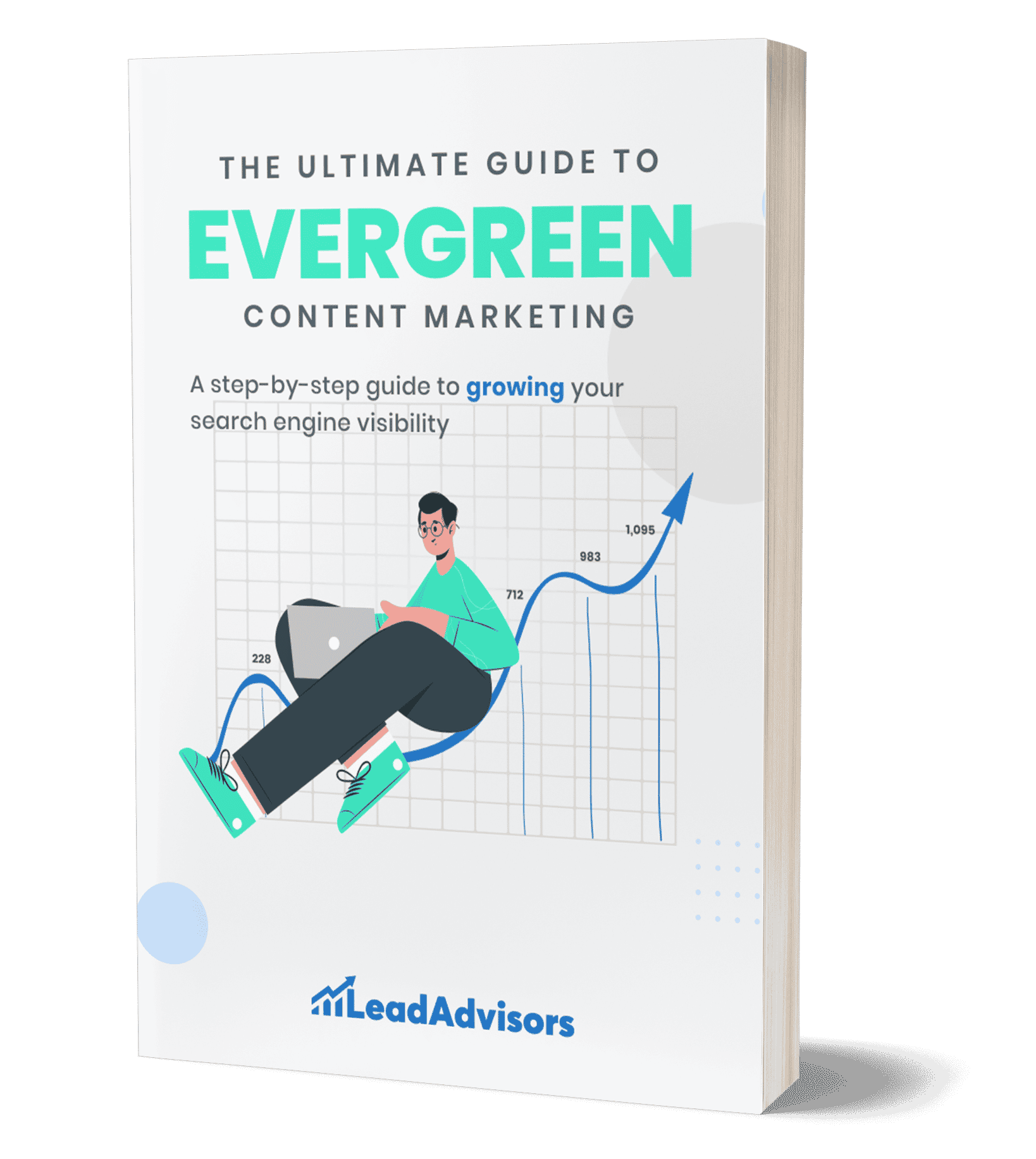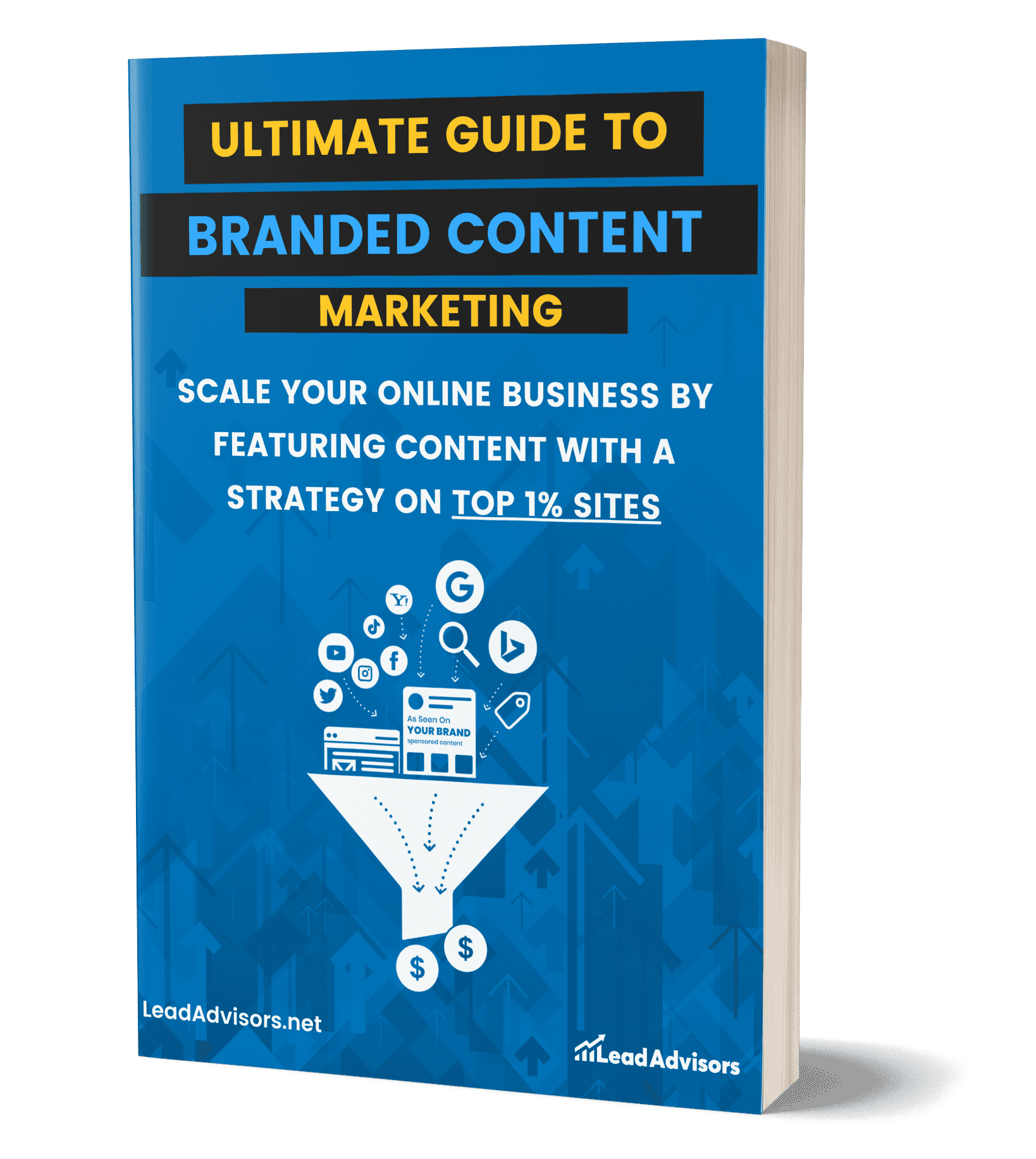Remember when the search results page was just ten blue links? Those days are extinct. Understanding what a SERP feature is and how to track SERP features is now essential for survival.
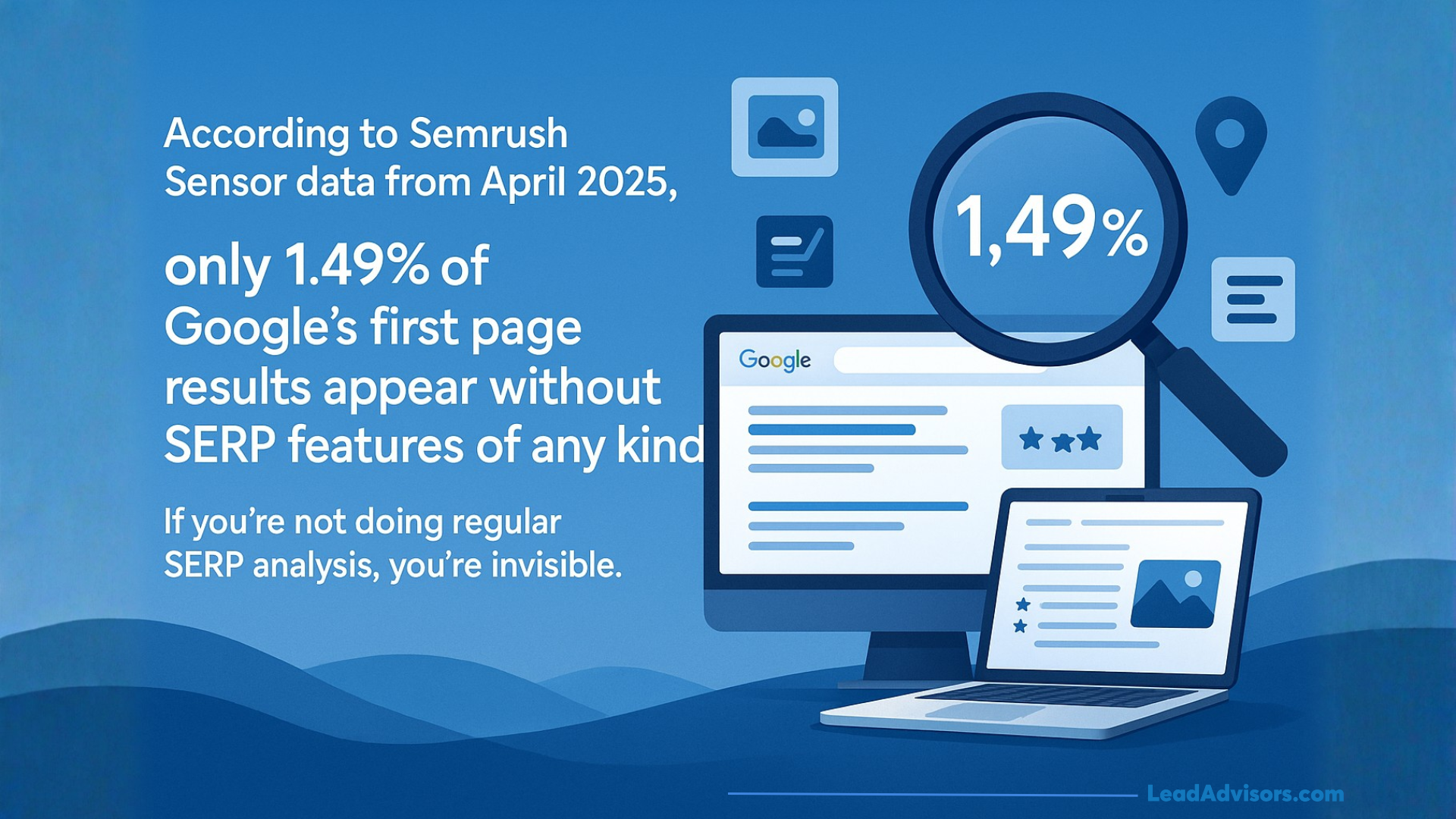
According to Semrush Sensor data from April 2025, only 1.49% of Google’s first page results appear without SERP features of any kind. If you’re not doing regular SERP analysis, you’re invisible.
Winning in 2025 means mastering AI Overview citations, improving SERP ranking across multiple feature types, and building undeniable brand authority across every SERP element.
TL;DR: What You Need to Know About SERP Features
- The landscape: 98.51% of Google’s first page now includes SERP features—AI Overviews, Featured Snippets, Local Packs, and more. Traditional organic rankings alone no longer guarantee visibility or traffic.
- The opportunity: Rich results get 58% of clicks vs. 41% for standard listings. Featured Snippets can boost CTR to 42.9%. Local Pack positions drive 126% more traffic than rankings 4-10.
- The challenge: 58-60% of searches are now zero-click. You must optimize for citations and brand visibility even when users don’t visit your site.
- Your action plan: Implement schema markup (72% of top results already do), target Featured Snippets and PAA boxes for quick wins, optimize your Google Business Profile for local searches, and track SERP feature ownership weekly using tools like Google Search Console, Ahrefs, or Semrush.
Bottom line: Stop obsessing over rankings. Start dominating SERP features. This guide shows you exactly how.
What Are SERP Features?
Before we get into what SERP features are, let me explain: SERP stands for “Search Engine Results Page”—the page Google (or any other search engine) shows after you make a search. Traditional SERPs were just simple organic listings, but the Google SERPs of today are like intricate ecosystems.
SERP features are those elements of the search results page that come after or without reference to the traditional organic search results. If you perform SERP SEO, you are not only positioning yourself for ranking but also for being seen in different feature types that may be present on the page.
Each type of SERP feature is defined as follows:
| Category | Feature Types | Primary Goal |
| Informational | AI Overview, Featured Snippets, People Also Ask, Image Pack, Video Carousel | Provide direct answers instantly |
| Commercial | Google Ads, Shopping Results, Rich Snippets, Popular Products, Site Links | Drive purchase decisions |
| Local/Entity | Local Pack, Knowledge Panel, Google Business Profile | Connect users to places & brands |
| News/Event | Top Stories, Google News, Related Searches | Surface timely content |
To enhance user experience, AI training, and user engagement, search engines continuously integrate common Google SERP features. How many SERP features appear is a matter of the search intent only – a mere branded query may reveal only 2-3 features, whereas a detailed informational query might result in more than six different features being activated. The features that are shown are determined by the intent of the user’s search query.
Why SERP Features Important for SEO
Let’s be direct: SERP rankings without visibility mean nothing. You could rank #2 in organic results but get zero clicks if AI Overviews, featured snippet boxes, and Google Ads dominate the top of the page. Understanding SERP visibility and conducting regular SERP monitoring are essential for realistic traffic projections.
Rich results get 58% of clicks, while non-rich results have a CTR of 41%, demonstrating the massive advantage of appearing in enhanced SERP features. Multiple features give you several chances to appear on the same page—higher CTR, stronger brand trust, and authority signals that feed back into your SERP rank.
The downside? In 2025, an estimated 58-60% of Google searches are “zero-click”, meaning users get the answer directly from the SERP. But if Google displays your brand in the answer, you’re still winning mindshare.
What to track using Google Search Console and SERP monitoring tools:
- SERP metrics like feature presence across your keyword serp portfolio
- CTR by feature type
- Impression share on the results page
- Citation frequency in AI Overviews
Use tools like Ahrefs SERP checker or similar SERP analytics platforms to track serp performance weekly. Understanding your SERP feature tracking workflow is as important as technical SEO fundamentals like site speed and crawlability.
The Most Important SERP Features in 2025
AI Overviews (AIO)

AI Overview represents Google’s biggest shift in how the search engine delivers information. AI Overviews appeared from nowhere in August 2024 and now appear on over a quarter of keywords, making this the fastest-growing SERP feature. This element appears at the top of the SERP above all other organic serp features, providing AI-generated summaries with clickable source citations. They’re designed to provide quick answers that satisfy the user’s search query without requiring clicks.
Optimization principles:
- Rank in the top 10 organically first—use tools like Ahrefs SERP to analyse SERP positions
- Cover topics comprehensively with structured data that helps Google understand context
- Use schema markup and clear question-answer formatting that provides a brief answer upfront
- Reinforce E-E-A-T signals through author credentials and best practices
- Optimize content to match the original search query intent precisely
Google’s knowledge graph uses these signals to determine which sources appear. Make your content citation-worthy by providing direct answers supported by evidence.
Featured Snippets
The featured snippet is basically the original “position zero”—a SERP feature that takes content from your page and shows it above the regular results. Featured snippets are available in around 19% of mobile SERPs, and if the first organic result is the one featured in this box, its click-through rate can increase up to 42.9%.
But, Featured snippets have been decreasing significantly from 15.41% of SERPs in January 2025 to 5.53% in June, which is highly correlated with the increase of AI Overviews. Still, Featured Snippets continue to be a valuable part of the search engine results page.
Optimization checklist:
- Frame H2 or H3 headings as questions matching user query patterns
- Provide a concise answer in 40–60 words immediately below (this becomes your potential SERP snippet)
- Follow with supporting details—lists, tables, or numbered steps work best according to best practices
- Include internal links to related content for additional information
Of queries made up of 10 words, 55.5% have a featured snippet, showing that long-tail keywords with high search volume but moderate keyword difficulty are particularly effective targets.
People Also Ask (PAA)
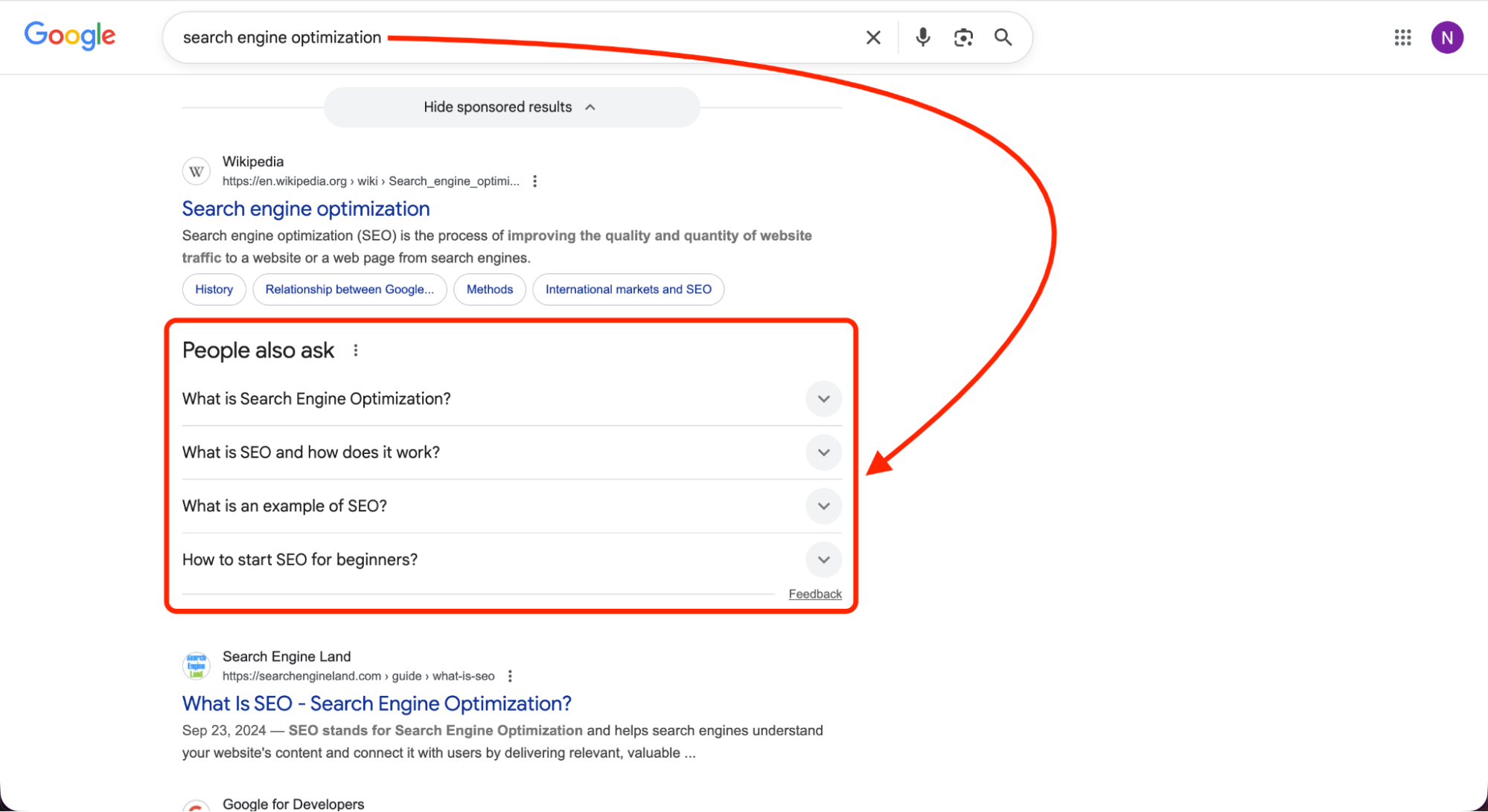
The People Also Ask box is a set of related queries that can be expanded one by one and is shown in the Google search results. People Also Ask boxes can be found in approximately 64.9% of all searches, thus being one of the most common SERP features.
Your optimization playbook:
- Use keyword research tools and conduct SERP analysis to identify question clusters related to your initial query
- Turn questions into H3 headings that match the user’s search query pattern
- Answer each in 1–2 tight sentences using best practices for concise content
- Refresh quarterly as Google tests new PAA questions constantly
Featured snippets get over one-third (35.1%) of the total click share, while PAA boxes typically receive lower engagement. However, PAA boxes dynamically expand when clicked, showing more related queries—capturing traffic from multiple specific search queries with a single page. This is one of many serp features that reward comprehensive topic coverage.
Optional power move: Add FAQPage schema markup if your content qualifies, but follow best practices.
Knowledge Panels
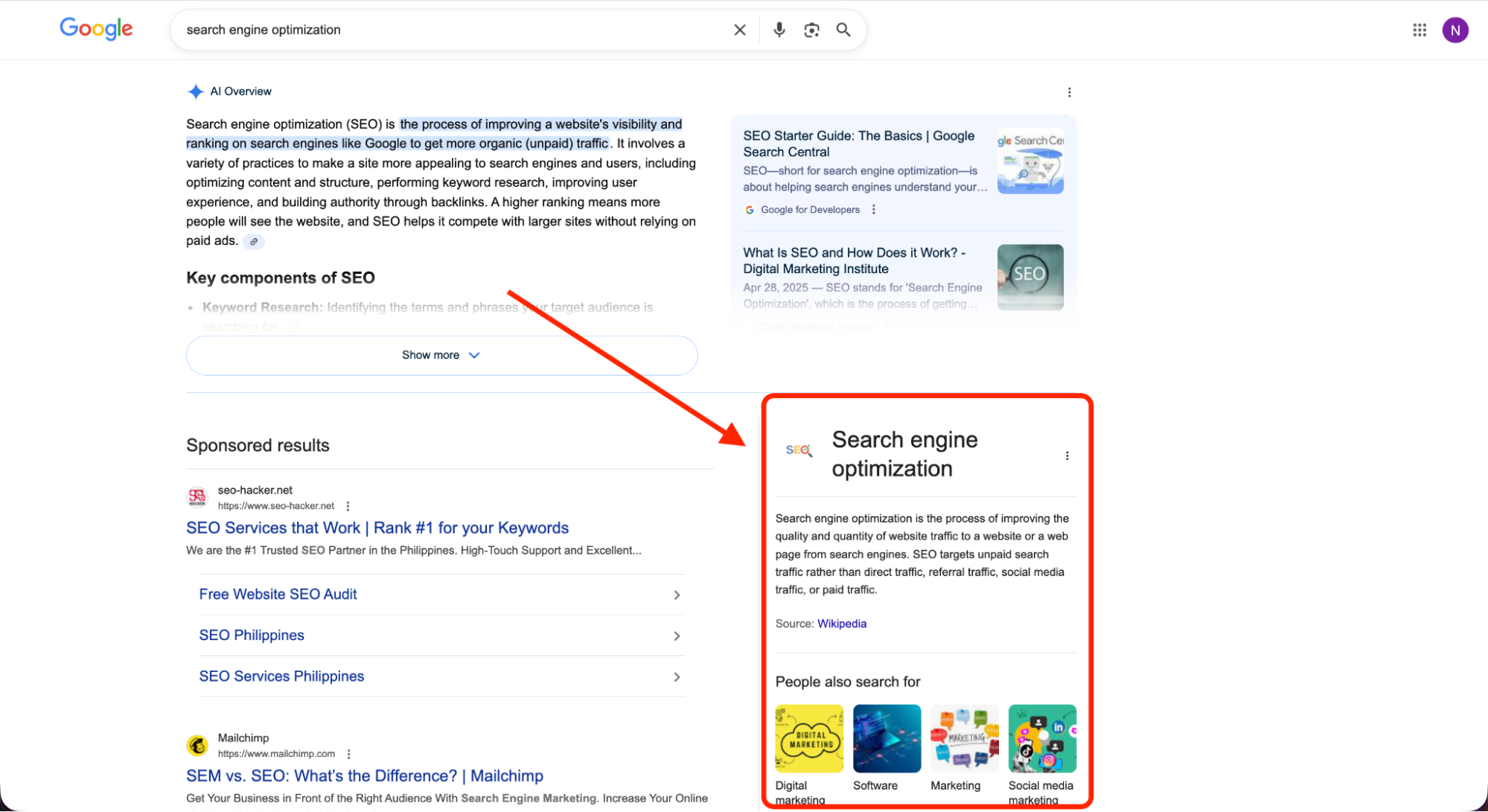
The Knowledge Panel is the area where the information is displayed visually. On the desktop, it is on the right side, and on the mobile, it is at the top of the screen. It is a product of Google Knowledge Graph and shows the information that has been verified about entities – brands, people, places, and things.
How to influence your Knowledge Panel:
- Claim your panel if eligible (organizations, public figures, verified brands)
- Implement Organization or Person structured data on your homepage
- Maintain consistency across your Google Business Profile, Wikipedia, LinkedIn, and website
- Build authority through branded searches and high-quality backlinks
Google Knowledge Graph depicts entities as nodes connected by relationships. 72% of the first-page results have schema markup, making them rich in features; however, most businesses are still ignoring this basic element.
Local Pack (Map Pack)

The Local Pack (also referred to as Local SERP or Map Pack) is extremely important for businesses that rely on location-based queries to get customers. This element is shown on top of Google SERPs, above the regular organic listings, displaying a map as well as three business listings.
Out of those who perform a local search, 42% click on the Google Map Pack results, and businesses that are in the Google 3-pack receive 126% more foot traffic and 93% more events, such as calls and website clicks, in comparison to those that are ranked from 4 to 10.
Optimization essentials for local SEO:
- Create and verify your Google Business Profile (free and critical for local SERP presence)
- Maintain NAP (Name, Address, Phone) consistency—include your phone number across all citations
- Actively collect and respond to customer reviews
- Add local photos, regular posts, and implement LocalBusiness schema markup
- Monitor your SERPS location performance using local rank tracking tools
The statistic that 76% of local searches with a clear local intent end up with a visit to a brick-and-mortar store within 24 hours is a testament to the great and immediate influence of Local Pack optimization.
Image & Video Packs

An Image Pack presents small pictures in a grid (like what you see when you do a Google Images search), whereas the Video Carousel has video thumbnails taken from YouTube and other sources. These are the new features that come up when the user is better visually served for their search—just imagine food recipes, DIY tutorials, and product comparisons.
For image search results optimization:
- Use descriptive filenames that match target keywords
- Write alt text that describes images for both users and search engines
- Compress images for a better user experience without sacrificing quality
- Add ImageObject structured data where relevant
For Video Carousel optimization:
- Upload to YouTube (Google prioritizes its own properties)
- Include timestamps and chapters to help the search engine understand your content
- Implement VideoObject schema markup with upload date, duration, and description
- Create compelling thumbnails that stand out
Both features are organic SERP features that can drive significant traffic when optimized correctly. They often appear alongside other serp features, creating multiple visibility opportunities on a single results page.
Rich Snippets & Popular Products
Rich snippets add visual enhancements to traditional results—star ratings, pricing, availability, pros/cons. These features make your organic listings stand out among standard blue links on the page.
Implementation steps:
- Add Product, Offer, and AggregateRating structured data to relevant pages
- Connect your product feed to Google Merchant Center
- Optimize your title tag and meta description for CTR
- Ensure pricing and availability are always current
Rich results get 58% of clicks, while non-rich results have a CTR of 41%, showing the substantial advantage these enhanced listings provide.
Top Stories & Events
Top Stories is a SERP feature that displays the most up-to-date content for trending topics and news-breaking queries. It is positioned at the top of SERPs for time-sensitive searches, thus getting more visibility than paid SERP features like Google Ads.
Eligibility requirements:
- Register your site in Google News Publisher Center
- Implement Article schema markup with publish date, author, and headline
- For events, add Event structured data with dates, location, and relevant details
- Maintain high editorial standards and publish regularly
This feature prioritizes freshness and authority. If your content plan is based on news or timely information, then it is necessary to be featured in Top Stories and Google News features to be visible in the SERP. Keep in mind that although other search engines have similar news features, Google’s Top Stories is still the most influential for traffic.
Advanced: Entity-First & Schema-Smart SEO
Modern search engine optimization isn’t just about crawling and indexing—it’s about helping Google understand your brand as an entity within its Knowledge Graph. Technical SEO now extends beyond site speed and mobile-friendliness to include structured data implementation and entity recognition. The search engine sees your site as a collection of interconnected entities, not just pages of blue links.
Key schemas:
- Organization and Person for brand and author identity
- BreadcrumbList for clear site structure
- Article for blog post and news content
- Product, FAQPage, HowTo, and Event were relevant
Validation workflow: Anytime that you add or update structured data, make sure that it is validated through Google’s Rich Results Test and Schema Validator. Small mistakes can prevent Google from showing the enhanced features that can harm your SERP rankings. Invalid schema, a technical SEO issue, can be the reason why you lose valuable SERP feature appearances.
Schema markup is used by 72% of the first-page results; however, 23% of websites do not have any structured data, thus, they are missing out on SERP enhancements. Most often, if a serp feature is present for your target keywords but you are not appearing, it means that you have not implemented schema.
Automation tip: Use your CMS to automate schema markup. WordPress, Shopify, and other platforms offer plugins that generate structured data automatically, reducing technical SEO issues and scaling your efforts across all the serp real estate you’re targeting.
Measuring & Monitoring SERP Features
You can’t optimize what you don’t measure. Understanding SERP visibility and tracking how many features your site owns versus competitors is critical.
Tools:
- Google Search Console → Search Appearance tab shows feature impressions and CTR
- Ahrefs SERP checker → Comprehensive tracking with historical data via SERP features history ahrefs
- Semrush Position Tracking → Track SERP features by keyword, filter by feature type
- SE Ranking → Monitor which feature appears for each tracked keyword
Track metrics:
| Metric | Tool | Frequency | KPI |
| SERP feature presence (%) | Semrush Position Tracking | Weekly | +10% QoQ |
| Click-Through Rate | Google Search Console | Monthly | Maintain > baseline after AIO rollout |
| Feature Type Visibility | SE Ranking / Semrush | Weekly | # of features owned |
| AIO Citation Count | Manual / API | Monthly | +% vs previous month |
| Local Pack Actions (calls, directions) | GBP Insights | Monthly | +MoM |
Track both organic features and paid elements if you’re running Google Ads campaigns. Understanding the full landscape of Google search results helps you allocate resources effectively.
Explore the different rank tracker tools to know more.
Step-by-Step Optimization Playbooks
Featured Snippet / AIO Block
- Add query as an H2 heading
- Write a 50-word direct answer beneath
- Follow with a list or table for additional information
- Cite sources, link deeper
Time investment: 10–15 minutes per page.
People Also Ask Block
- Research 4–8 relevant questions using AlsoAsked or Semrush
- Add each question as an H3 heading
- Write 1–2 sentence answers
- Use bullet or numbered lists where possible
- Interlink related pages
Time investment: 20–30 minutes per page.
Product / Rich Result
- Add pros/cons list and pricing table
- Implement Product, Offer, and AggregateRating schema markup
- Upload a unique, high-quality product image
- Sync product feed with Google Merchant Center
Time investment: 30–45 minutes per product page (one-time setup).
Local Pack
- Optimize GBP: complete hours, services, photos, posts, phone number
- Add LocalBusiness structured data to your website
- Ensure NAP consistency across all directories
- Encourage reviews and respond within 24–48 hours
Time investment: 1–2 hours upfront, 30 minutes weekly for maintenance.
Common Pitfalls to Avoid
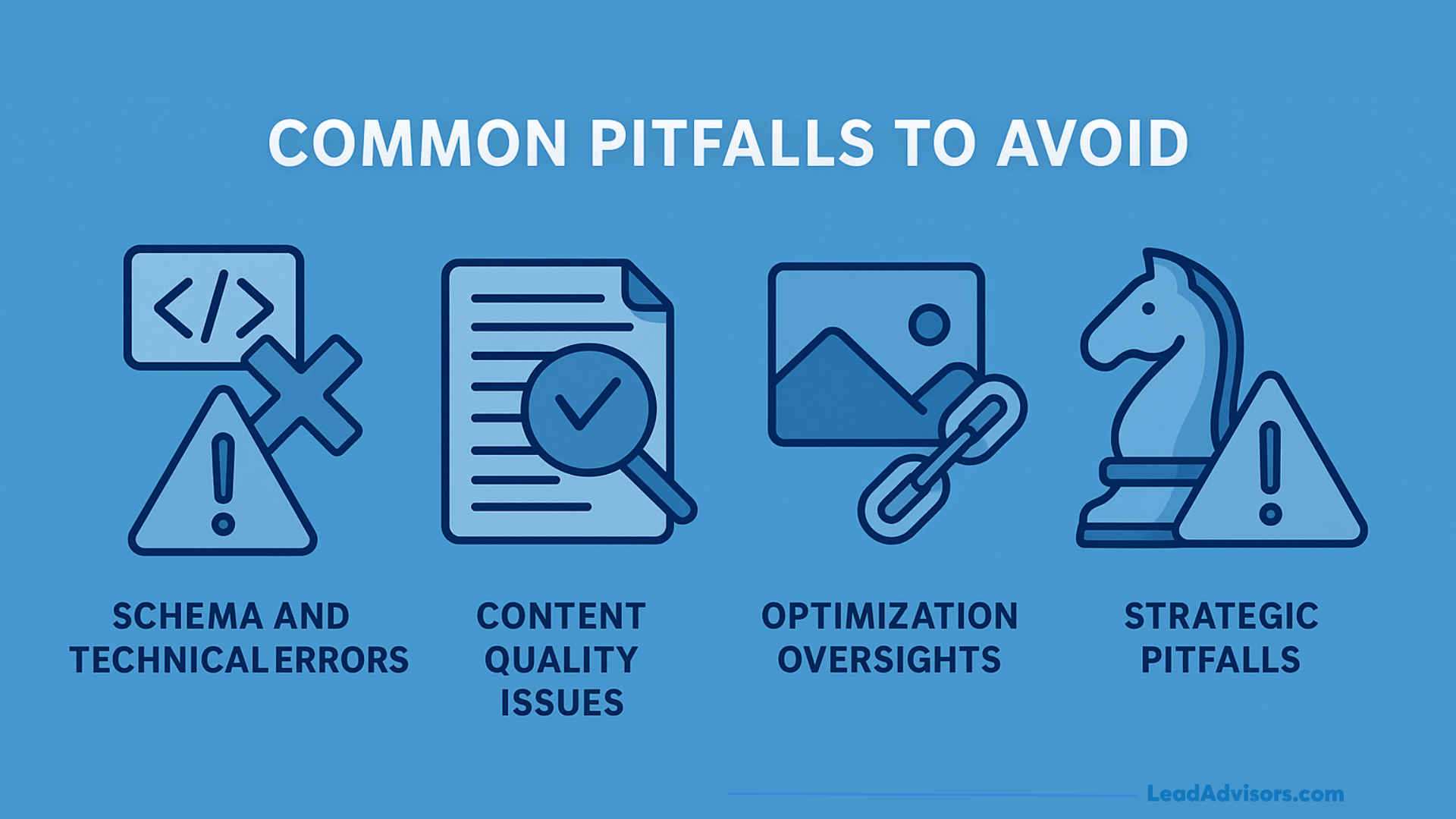
Even small errors can prevent you from capturing valuable SERP positions:
Schema and technical mistakes:
- Over-stuffing structured data or marking up content that doesn’t exist
- Implementing conflicting schema markup types
- Ignoring validation errors from Rich Results Test
- Not following schema markup best practices
Content quality issues:
- Providing answers under 30 words (too thin for Featured Snippets)
- Failing to update content regularly (Google favors fresh timestamps)
- Missing the search intent behind queries
- Creating content without considering what Google displays for that query type
Optimization oversights:
- Skipping alt text for images
- Forgetting internal links that help the search engine understand content relationships
- Incomplete entity profiles (inconsistent NAP, missing Google Business information)
- Poor user experience that increases bounce rates
Strategic missteps:
- Targeting queries dominated by Google Ads without considering zero-click implications
- Ignoring other features like Google Flights for travel queries or shopping carousels for e-commerce
- Failing to monitor traditional organic results alongside enhanced SERP features
- Not adapting content when Google displays different elements
- Overlooking opportunities in niche verticals where fewer competitors optimize for all the serp features available
Tracking Template (Summary Table)
Copy this framework and customize it for your keyword serp portfolio:
| Metric | Tool | Frequency | KPI |
| SERP Feature Presence (%) | Semrush Position Tracking | Weekly | +10% QoQ |
| Click-Through Rate | Google Search Console | Monthly | Maintain > baseline after AIO rollout |
| Feature Type Visibility | SE Ranking / Semrush | Weekly | # of features owned |
| AIO Citation Count | Manual / API | Monthly | +% vs previous month |
| Local Pack Actions (calls, directions) | GBP Insights | Monthly | +MoM |
| Rich Snippet display rate | Search Console + SERP checker | Weekly | Increase eligible pages |
| Knowledge Panel accuracy | Manual review | Monthly | Maintain correct information |
| SERP volatility index | Rank tracking software | Daily | Monitor major fluctuations |
Pro tip: Use SERP checker tools to filter keywords by those where a specific feature appears, then analyze your win rate. This SERP analysis shows you exactly where to focus optimization efforts.
Frequently Asked Questions
What's the difference between AI Overviews and Featured Snippets?
Do SERP features reduce my traffic?
What schema types most influence visibility?
How can I track which SERP features my site owns?
What's the easiest SERP feature to win first?
Conclusion: Own Your SERP Real Estate Before AI Does
The search results page is your new storefront. Every feature is a shelf, every citation is social proof, and every impression builds trust—even if it doesn’t result in a click.
In April 2025, only 1.49% of Google’s first page results are without Google SERP features of any kind. Your strategy needs to shift from “rank higher” to “appear everywhere that matters.” That means structured content, clean schema markup, entity consistency, and relentless measurement.
Key takeaways:
- AI Overviews now appear on over a quarter of keywords, fundamentally changing the SERP landscape
- Rich results get 58% of clicks, making schema optimization non-negotiable
- 42% of local searches click on Google Map Pack results, prioritizing local SEO
- 72% of first-page results use schema markup, while 23% miss this opportunity entirely
The SERP evolves faster than algorithms now. Set quarterly reviews, track what earns clicks (not just rankings), and iterate ruthlessly. Because in 2025, the brands that win aren’t just SEO-savvy—they’re SERP-native.



